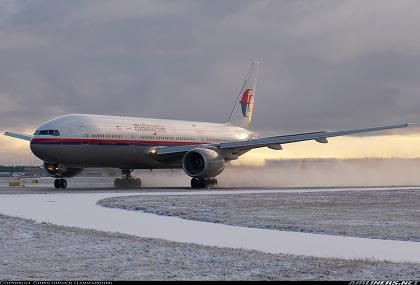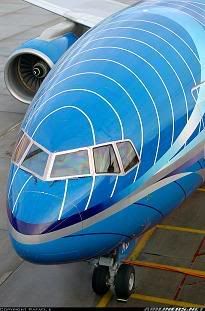Aircraft Snow Removal
Yawn, waking up at 10a.m feels great! For all u working friends haha! are u jealous?? :P bluekkkk... I better enjoy my student life before the working life starts to haunt me. By then, u'll be laughing at me instead because i even have midnight shifts on big days like Xmas, CNY, Raya & Deepavali! (triple pay though haha!)
It's winter season in most of the cold countries, children and maybe SOME adults overseas are playing snowball in their yard and making snowman with carrots cucuk-ed as nose; and back here in Malaysia, children and ALL adults in the northern states are shifting tv, pc monitor, microwave... to higher ground, thank God selangor is fine.
Snow can be fun for us to play with. It's soft, it's cold, it's just oh-so-beautiful to us Malaysians who have not seen snow before, that includes me. However, snow can be disastorous to aircrafts. Not only it is a very effectice aerodynamic spoiler (changes the shape of the surface), but also it adds a significant amount of weight and drag, to name a few.

Yellow bird - DHL having a hot bath with V.S.O.P
During flights, snow accumulation is quite minimal as the strong on-coming wind will blow the snow off the aircraft surfaces. It is on ground, when the planes are parked, that snow tends to accumulate on the aircraft, especially the wings for its large horizontal surface. Knowing that it is disastorous to fly with snow, so some methods of removing them is compulsory before takeoff is allowed.
Procedures of removing snow range from a low tech broom to sophisticated chemicals. Airlines most commonly use a truck mounted mobile de-icer/anti-icer, just like the picture shown above where DHL is having a hot bath. These units generally consist of one or more fluid tanks, a heater to bring the fluid to a desired application temperature, and a spraying nozzle. The dispensing system is capable of supplying fluid at various pressures and flow rates with an adjustable spray pattern at the nozzle. It's something like the nozzle we use to water our plants in the garden.
So, what chemical is being sprayed as shown? definitely it wouldn't be water, because water freezes easily during winter, which would then form stalagtite on the plane and stalagmite on the airport floor haha! Therefore, some sort of chemical having a freezing point lower than 0 degree (water freezing point) is preferred. Generally, airlines are using a mixture of isopropyl alcohol and ethylene glycol as the chemical. Mind u, these alcohol are not consumable like V.S.O.P or Chivas Regal ya!!! (u need like 1000 bottles of vsop to pour over a plane!)

When everything is white, the red blue Wau stands out.
If the plane is covered heavily by snow, the ground crews will firstly spray a greater amount of diluted chemical, usually heated, to remove accumulated ice, snow, or frost (de-ice). The dilution must protect from refreezing long enough for the second step (anti-icing) to be completed. During anti-acing, a more concentrated fluid is applied to the uncontaminated surfaces. How concentrated? well that depends upon weather conditions, required holdover time (length of time surface will be protected) and it is applied cold.
De-ice and anti-ice airplanes as close to the departure time as possible, especially when bad weather conditions cause shorter holdover time. Fortunately, we aircraft engineers in malaysia dun need to encounter such problems, and that means less work! But come to think of it, engineers overseas dun do it too. All aircraft engineers do is to order ppl to do things, and when it's done, get to the site and inspect and sign the papers, done! Easy job huh? But dun forget, that signature holds everyone on board's life.
 Kampungkai is a name, and also a place in the virtual world where u read about his lovely writings. It's interesting, it's addictive. Do visit kampungkai during your free time and call out loud KAMPUNGKAI if u do see me!
Kampungkai is a name, and also a place in the virtual world where u read about his lovely writings. It's interesting, it's addictive. Do visit kampungkai during your free time and call out loud KAMPUNGKAI if u do see me!

11 Comments:
Why can't they supply you people with flame thrower? That will be cool, right? :P Kidding.
You copy all these from your textbook izzit? :P
By Anonymous, at December 20, 2005 2:17 PM
Anonymous, at December 20, 2005 2:17 PM
this fella has been no 1 in all my comment page! damn! hahaha...
eh, i got all that info up here (pointing to brain) ok!? Everything is spontaneous! i write what comes to mind. Why, i sound like textbook? sob... sorry lo, i know it's boring.
By Kampungkai, at December 20, 2005 2:37 PM
Kampungkai, at December 20, 2005 2:37 PM
And I thought it was Salt water to melt the snow and heavy concentrated amount of sodium will not freeze up water. (and it's cheaper)
Hmm... Wouldn't isopropyl alcohol in mist form explode from a simple small spark?
By Gulengz, at December 20, 2005 2:45 PM
Gulengz, at December 20, 2005 2:45 PM
gulengz: whassup dude, nice to meet u.
Yes, salt water lowers water's freezing point, but as salt water evaporates, it leaves salt(sodium) particles on the aircraft surface, and these salt are VERY CORROSIVE to the a/c surface, besides all these lil particles causes uneveness on the a/c surface, thus disrupting airflow, and lift is destroyed, so salt water is out.
Yes, u r right, alcohol is extremely flammable. But i dun think one can bring a lighter near an aircraft? One will be shot down even before stepping near the a/c. All de-icing and anti-icing procedures are done under strict supervision, and viscosity of alcohol is controlled. Besides, some other chemicals are definitely added to overcome the problem like u mentioned, the aviation industry will always have fail-safe thinking or so called backup plans. (i'm not sure what other chemicals are they, but will let u know if i get to know k?)
Dude, nothing in aviation industry is CHEAP! hahaha... cheers!
By Kampungkai, at December 20, 2005 3:15 PM
Kampungkai, at December 20, 2005 3:15 PM
i think they pour samsu lei to wash the plane. the washing crew will always be mabuk liao. cheers!
By JoeC, at December 20, 2005 4:00 PM
JoeC, at December 20, 2005 4:00 PM
what? I also sleep until 10am what, but with two minkey jumping around lar.
got kaki-bottle stand below the plane to "drink" or not, when the plane take "hot bath" hehehe...
don't bother with Jason, just keep all this interesting info coming.
By Anonymous, at December 20, 2005 5:23 PM
Anonymous, at December 20, 2005 5:23 PM
Last time I watched a tv documentary.. cleaning a jumbo jet cost $300,000 (forgot USD or RM) every time.. true or not??
By Anonymous, at December 20, 2005 5:49 PM
Anonymous, at December 20, 2005 5:49 PM
joec: *walks to the wall, bang my head on the wall. (lol)
maria: wake up earlier la! the kids will be starving for breakfast! lol. hot alcohol, sounds like SAKE!
jee: OMG! 300,000 for a wash? wow! i think what they meant was undergoing overhaul to the a/c. Meaning that they strip the plane into pieces, only left with the skeleton. Then remove the paint of everything, then inspect for cracks, service, repaint, and reinstall. Major service. From what i know, washing planes only need water and soap and brooms and mops. will find out4u 1 day k?
hushnow: jason has this notifier thingy, u gotta install that in order to beat him! nvm... if u r no2, i'll still consider u as no1! haha... ignore jason! kampung party, so what's the dress code? i'll dress as a chicken mascot, u? HUSHpuppy mascot? lovely!!!!
By Kampungkai, at December 21, 2005 2:07 AM
Kampungkai, at December 21, 2005 2:07 AM
longchamp outlet, replica watches, nike air max, oakley sunglasses, christian louboutin uk, ray ban sunglasses, nike free, longchamp pas cher, cheap oakley sunglasses, tiffany and co, jordan shoes, nike air max, christian louboutin, louboutin pas cher, ray ban sunglasses, prada handbags, oakley sunglasses wholesale, polo outlet, kate spade outlet, longchamp outlet, longchamp outlet, michael kors pas cher, prada outlet, gucci handbags, ugg boots, christian louboutin outlet, louis vuitton outlet, louis vuitton, chanel handbags, nike roshe, jordan pas cher, nike free run, air max, louis vuitton outlet, tory burch outlet, oakley sunglasses, oakley sunglasses, ray ban sunglasses, sac longchamp pas cher, louis vuitton, tiffany jewelry, nike outlet, christian louboutin shoes, polo ralph lauren, louis vuitton outlet, ugg boots, replica watches, uggs on sale
By oakleyses, at April 21, 2016 10:47 AM
oakleyses, at April 21, 2016 10:47 AM
iphone 6s cases, chi flat iron, ipad cases, north face outlet, hollister, ralph lauren, wedding dresses, nike air max, north face outlet, louboutin, baseball bats, insanity workout, iphone 6 plus cases, soccer jerseys, celine handbags, asics running shoes, ferragamo shoes, mcm handbags, valentino shoes, p90x workout, nike roshe run, babyliss, timberland boots, nfl jerseys, iphone cases, lululemon, iphone 5s cases, ghd hair, iphone 6 cases, mont blanc pens, longchamp uk, hollister clothing, beats by dre, reebok outlet, instyler, s6 case, oakley, bottega veneta, hermes belt, soccer shoes, herve leger, jimmy choo outlet, mac cosmetics, abercrombie and fitch, new balance shoes, nike trainers uk, iphone 6s plus cases, nike huaraches
By oakleyses, at April 21, 2016 10:52 AM
oakleyses, at April 21, 2016 10:52 AM
canada goose outlet, canada goose, swarovski crystal, canada goose, canada goose, karen millen uk, ray ban, coach outlet, wedding dresses, moncler, louis vuitton, moncler outlet, swarovski, moncler, ugg,ugg australia,ugg italia, juicy couture outlet, moncler, marc jacobs, barbour, gucci, ugg,uggs,uggs canada, toms shoes, links of london, supra shoes, pandora charms, doudoune moncler, hollister, canada goose outlet, ugg, converse, replica watches, pandora jewelry, pandora uk, ugg uk, barbour uk, moncler uk, moncler outlet, hollister, louis vuitton, louis vuitton, canada goose outlet, ugg pas cher, montre pas cher, louis vuitton, moncler, juicy couture outlet, louis vuitton, vans, canada goose uk, thomas sabo, canada goose jackets, nike air max, converse outlet
By oakleyses, at April 21, 2016 10:55 AM
oakleyses, at April 21, 2016 10:55 AM
Post a Comment
<< Home